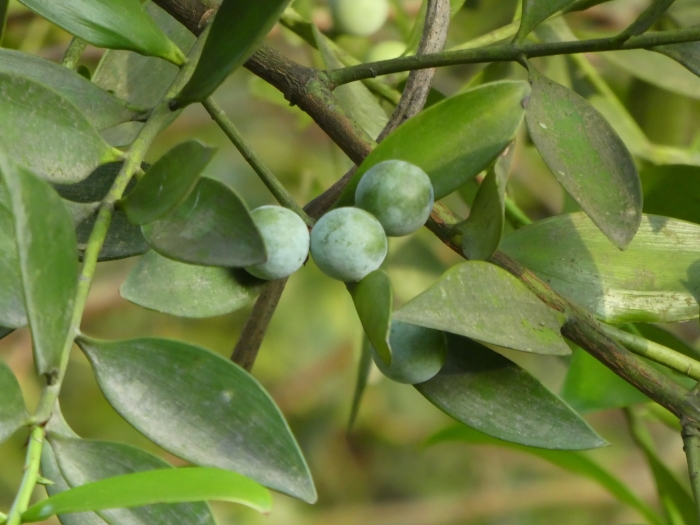Asian Bayberry
(Nageia nagi)
Asian Bayberry (Nageia nagi)
/
/

Aaron Liston
CC BY 4.0
Image By:
Aaron Liston
Recorded By:
Copyright:
CC BY 4.0
Copyright Notice:
Photo by: Aaron Liston | License Type: CC BY 4.0 | License URL: http://creativecommons.org/licenses/by/4.0/ | Rights Holder: Aaron Liston | Publisher: iNaturalist | Date Created: 2017-08-02T17:43:08-07:00 |




























Estimated Native Range
Summary
Nageia nagi, commonly known as Asian Bayberry, is an evergreen tree native to the subtropical forests and coastal regions of Southeastern China, Japan, and Taiwan. It typically grows to a height of 15-20 meters and has a slow growth rate. The tree features a conical form when young, becoming more rounded with age. The foliage is glossy and dark green, with leaves resembling those of the bay laurel, which contributes to its common name. Nageia nagi produces inconspicuous male and female cones on separate trees, with pollination dependent on wind. It does not produce showy flowers or fruits, but its dense foliage and attractive form make it a valuable ornamental plant.
Asian Bayberry is appreciated for its hardiness and adaptability to a range of weather conditions, making it suitable for urban environments and coastal landscapes. It is often used for screening or as a specimen tree in parks and large gardens. The tree’s preference for moist sites should be considered when planting, as it thrives in well-drained, sandy soils. While it can tolerate full sun, it also grows well in part shade, making it versatile for different garden settings. Asian Bayberry can be propagated by cuttings or seeds, with seeds requiring a warm greenhouse environment initially. Planting in the permanent location is recommended for late spring or early summer after the last frost to avoid cold damage. Potential problems include susceptibility to root rot in overly wet conditions and the need for space to accommodate its eventual size.CC BY-SA 4.0
Asian Bayberry is appreciated for its hardiness and adaptability to a range of weather conditions, making it suitable for urban environments and coastal landscapes. It is often used for screening or as a specimen tree in parks and large gardens. The tree’s preference for moist sites should be considered when planting, as it thrives in well-drained, sandy soils. While it can tolerate full sun, it also grows well in part shade, making it versatile for different garden settings. Asian Bayberry can be propagated by cuttings or seeds, with seeds requiring a warm greenhouse environment initially. Planting in the permanent location is recommended for late spring or early summer after the last frost to avoid cold damage. Potential problems include susceptibility to root rot in overly wet conditions and the need for space to accommodate its eventual size.CC BY-SA 4.0
Plant Description
- Plant Type: Tree
- Height: 30-50 feet
- Width: 15-25 feet
- Growth Rate: Moderate
- Flower Color: N/A
- Flowering Season: Spring
- Leaf Retention: Evergreen
Growth Requirements
- Sun: Full Sun, Part Shade
- Water: Medium
- Drainage: Slow, Medium, Fast
Common Uses
Drought Tolerant, Edible*Disclaimer: Easyscape's listed plant edibility is for informational use. Always verify the safety and proper identification of any plant before consumption.
Natural Habitat
Subtropical forests and coastal regions
Other Names
Common Names: Negeia, 竹柏, 竹柏;山杉, 죽백나무
Scientific Names: , Nageia nagi, Podocarpus nagi, Myrica nagi, Nageia formosensis, Podocarpus formosensis, Decussocarpus nagi, Nageia nankoensis, Podocarpus nageia, Podocarpus nankoensis
GBIF Accepted Name: Nageia nagi (Thunb.) Kuntze